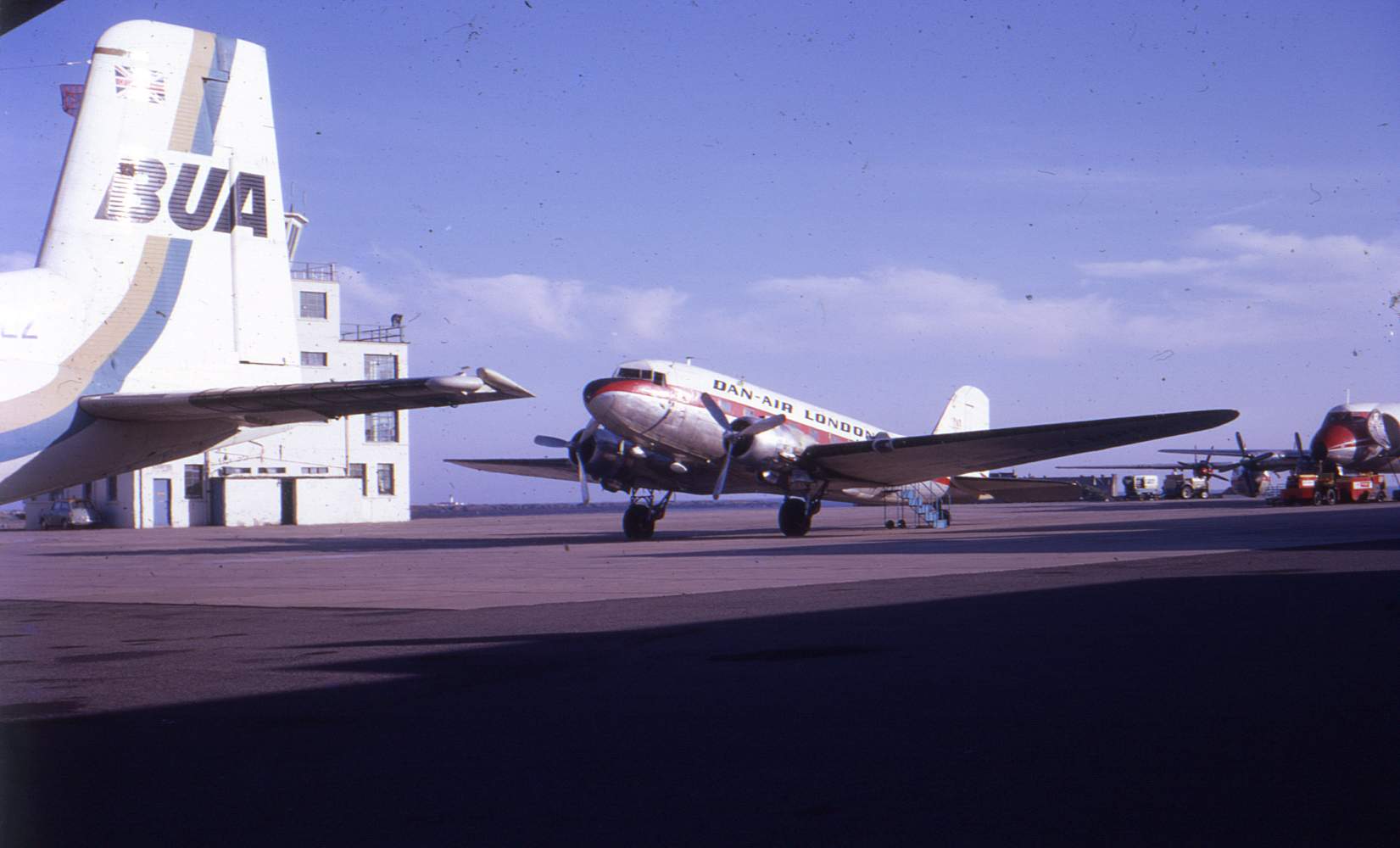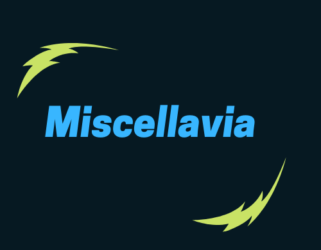G-AMWV was a key part of the British United (CI) Airways fleet which used to ply back and forth between Ronaldsway, Isle of Man, and destinations such as Blackpool, Belfast and Leeds. I was used to seeing the Dakotas shuttling in and out like clockwork throughout the summer months of the mid sixties, wearing the familiar black cheat line and red titles of British United.
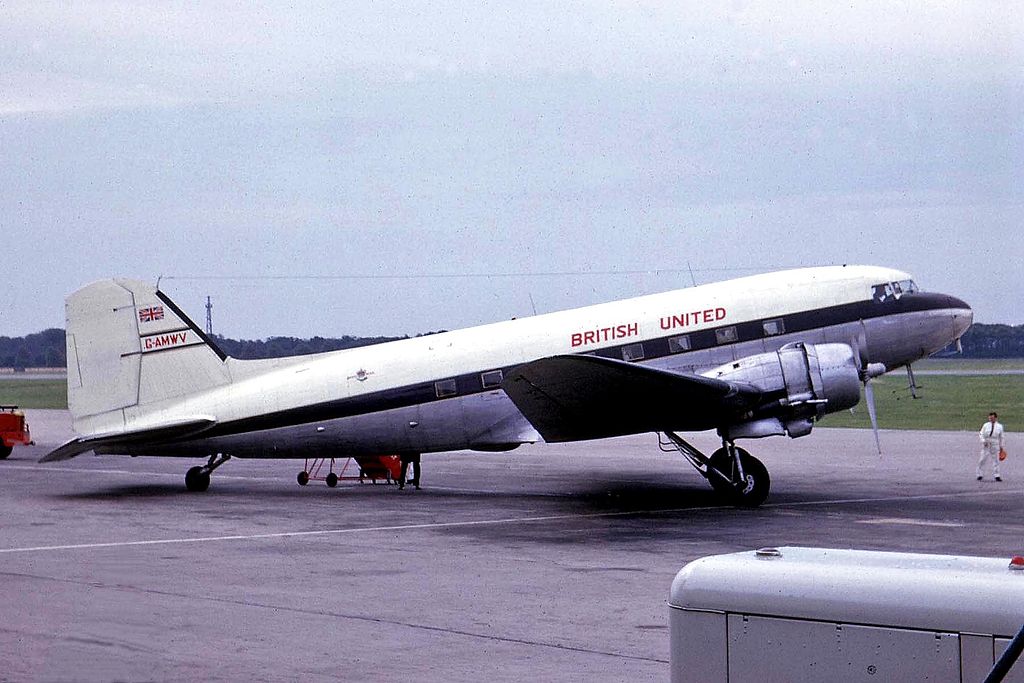
The airline had evolved from many diverse strands, which included some of the most important names in British civil aviation, and it was continually being re-organised. British United (CI) was formed to incorporate Jersey Airlines and elements of Silver City which, in turn, had absorbed Manx Airlines and the Lancashire Aircraft Corporation amongst others. For me, the British United Dakotas and Handley-Page Heralds constituted a defining moment at Ronaldsway along with Dan Air’s Ambassadors, Martin Baker’s Dakota, Cambrian and Aer Lingus Viscounts and the slightly rarer visitors such as Autair’s Heralds and Ambassador and Strathair’s Dakota. However, 1965 and 1966 were only fleeting moments and, by spring 1966, the BUA Dakota fleet was being dispersed. G-AMWV and G-AMWX were among the first to go, being registered EI-APB and EI-APJ respectively to Air Charters of Ireland. By the summer of 1966, they were appearing regularly at Ronaldsway in the colours of Hibernian Airlines. The tale of Hibernian and its successors Emerald Airways, Ulster Air Transport, Phoenix Airlines and Air Ulster is considered in a separate thread. EI-APB duly returned to her UK registration as G-AMWV and continued to ply the Irish Sea routes between Northern Ireland, the IoM and Prestwick until, eventually, she was withdrawn from use at Prestwick and dismantled. She was later trucked to Glasgow Abbotsinch where she joined G-ALYF to become a long term resident of the Airport Fire Training Ground. It was here that I last saw G-AMWV on a sunny morning in early June 1972.
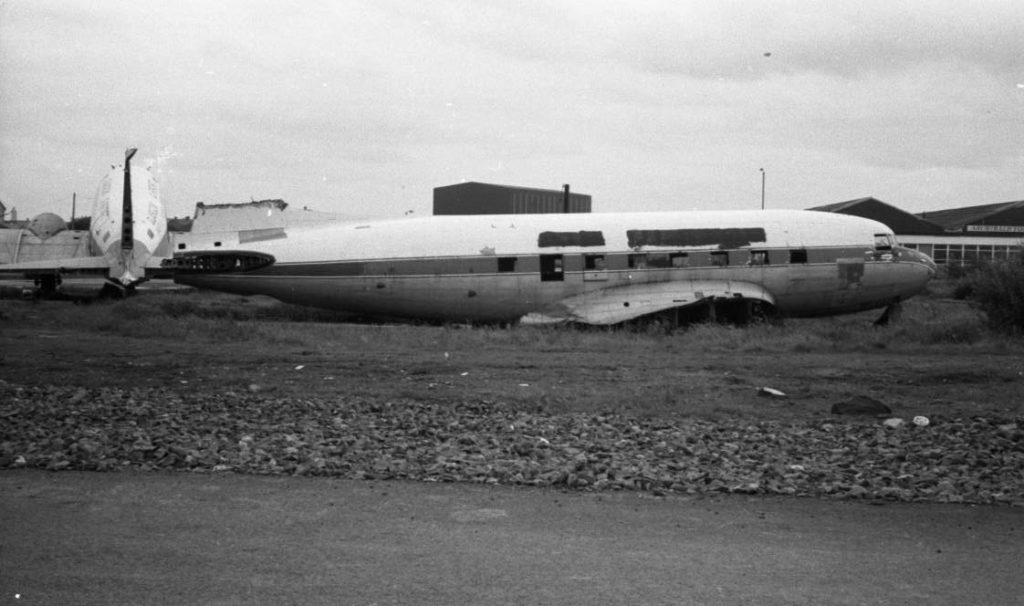
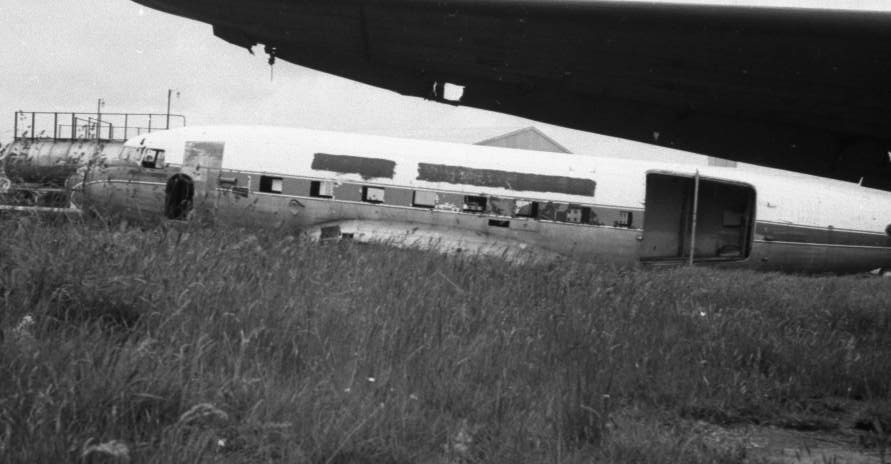
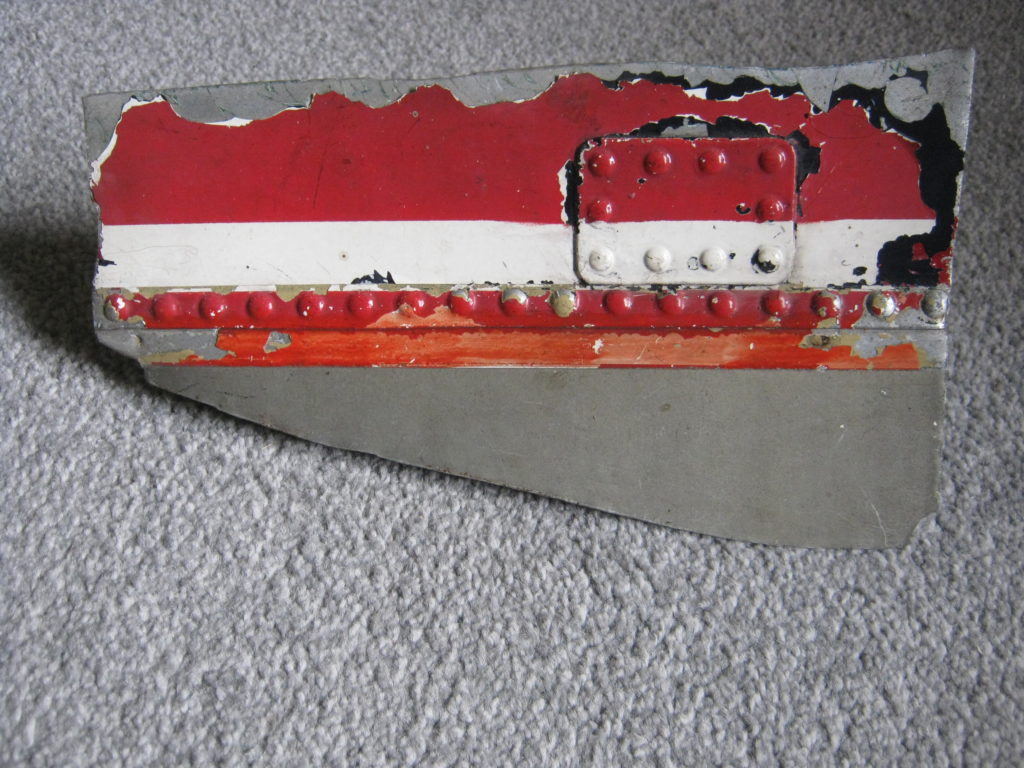
G-AMWV was built late 1943 in Oklahoma City where she was allocated the construction number 14155, later amended to 25600. Taken on charge by USAAF as 43-48339 on 15th August 1944, she was supplied to the RAF three days later via the Lend/ Lease programme with the serial KJ816. Received on 18th August 1944 by Air Command South East Asia, she served in India until 1946 before returning to Britain for demob at 12 Maintenance Unit, RAF Kirkbride, Cumberland in April 1947(1). Little is recorded for the next few years, but the aircraft may have been retained by the RAF while the cold war issues of the Berlin Airlift persisted.
At the end of 1952 the Lancashire Aircraft Corporation (LAC) purchased G-AMWV. The LAC name may not be as well known as that of contemporaries such as Skyways, Silver City and Dan Air but they were one of the most influential post war charter operators and were truly representative of many phases of British civil aviation in the forties and fifties. Formed during World War 2 at Salmesbury Airfield near Preston, Lancashire, LAC followed the pattern of being an airline with a parallel engineering support firm, Salmesbury Engineering. Their air charter service commenced in January 1946 and moved to Blackpool’s Squires Gate Airport for the summer season using Dragon Rapides. Their future operations would follow several branches, but the initial passenger services from Blackpool to the Isle of Man, Jersey, Exeter, Leeds etc created a route network which would be replicated by LAC’s successors Silver City and British United (CI) Airways. A different element of LAC’s business involved the purchase of redundant RAF Halifax bombers for conversion to civil freighters by Salmesbury Engineering. A sizeable fleet was purchased but, of these, possibly as many as 27 were used as spares donors- in the same way as Scottish Aviation purchased Dakota spares from the retired RAF stock at Silloth and Kirkbride. It was possible to purchase ex-service Halifaxes for as little as £200 each and freight charters around Europe could earn as much as £6-800 per charter – clearly scope for profit. The LAC Halifaxes that were converted and did join the civil register ranged the World on ad hoc charters from bases at Bovingdon, Blackbushe and Dunsfold. Their cargoes were typical of post-war charter operations: high urgency or perishable goods such as fruit and vegetables from Europe and ships spares worldwide. LAC also gained experience of airlifting fluids during the summer 1948 ‘milk airlift’ from Belfast, where there was a surplus of milk, to Lancashire when it was in short supply (2). The end of this operation overlapped with the start of the Berlin Airlift in October 1948 and LAC contributed a substantial fleet of 13 Halifaxes. Of these, ten had been converted to tankers and, by the end of the airlift, LAC had flown a total of over 15,000 tons of fuel into the beleaguered city on 2577 missions (3). Aircraft conversion and maintenance was carried-out by LAC’s own engineering personnel at Salmesbury Engineering and Yeadon Engineering. These companies were all under the control of one of Britain’s post-war aviation geniuses: J.Eric Rylands. He was an aviation pioneer with the same breadth of vision as Freddy Laker at Aviation Traders, Harold Bamberg at Eagle, Mike Keegan at Crewsair/ BKS/ Transmeridian and David McIntyre at Scottish Aviation (4).
In Spring 1951, Eric Rylands was joined by David Brown (of David Brown Tractors/ Aston Martin fame) who became Chairman of the company. In May 1951 LAC cannily bought BOAC’s 23-strong York fleet (5) to replace the Halifax/ Haltons and, in March of the following year, took over Skyways. The Yorks were transferred to Skyways, then based at Bovingdon, and assigned to profitable government trooping contracts servicing various military hot spots around the globe. While this ‘long distance’ aspect of the company prospered, it was considered time to re-vamp LAC’s domestic operations and a plan was made to supplement the capacity of the Rapides and Airspeed Consuls with a small fleet of Dakotas.
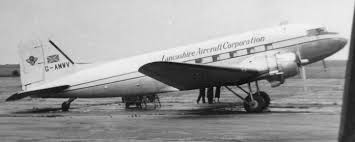
G-AMWV was registered to Lancashire Aircraft Corporation Limited at Salmesbury aerodrome on 4th December 1952 and was followed by G-AMWW and G-AMWX the next day. G-AMWV was the first of the Dakotas to commence passenger operations and flew on the Blackpool to IoM, Blackpool to Jersey and Birmingham to IoM routes (6). G-ANAE joined on 15th June 1953 and the four-strong DC-3 fleet was employed on both schedule and charter operations. As with earlier LAC projects, charters frequently included ship spares, vessel crew changes and the transport of perishables. An inclusive tour was operated each week between Manchester and Tarbes, close to the pilgrimage site at Lourdes in Southern France. The latter speciality was developed on a much larger scale in the 1950s by Liverpool-based Starways. From a 1953 passenger total of 21,000, expansion led to over 30,000 passengers during 1954.
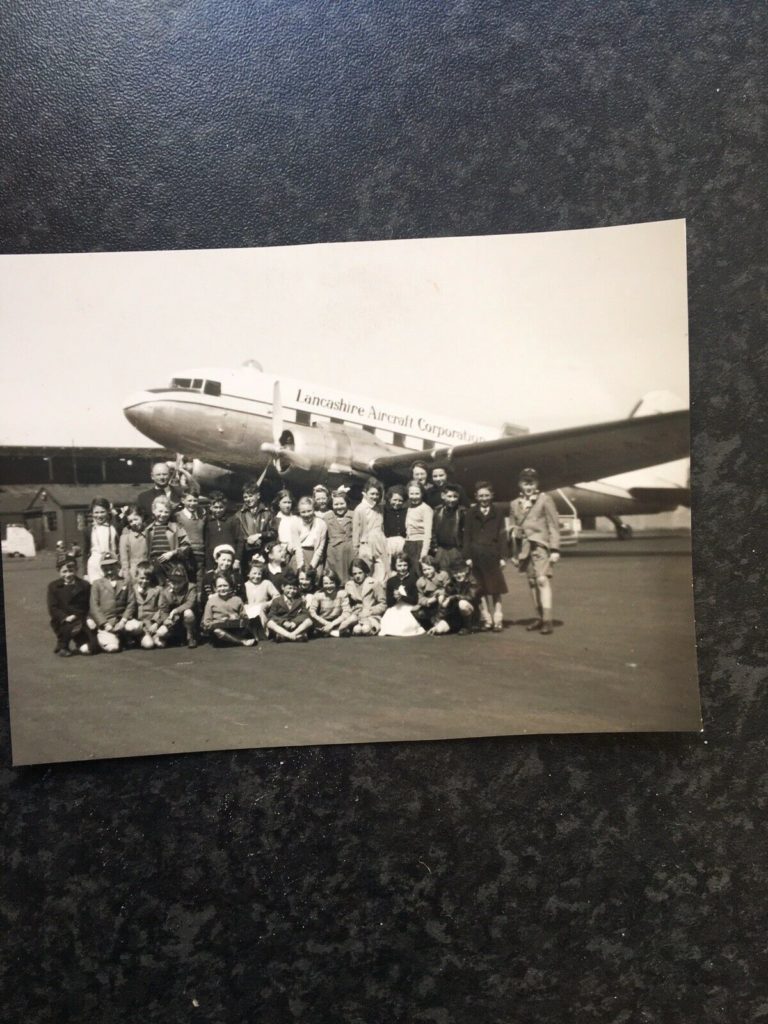
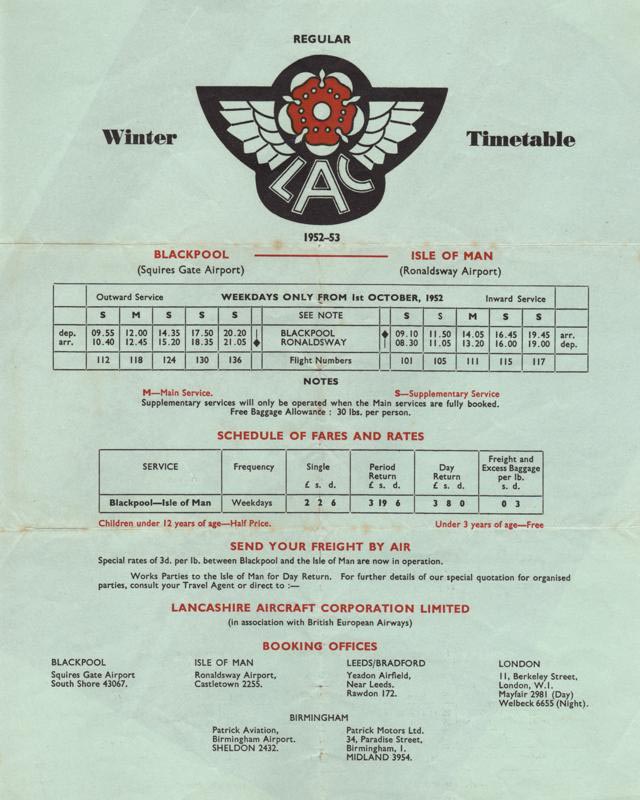
Further inclusive tour operations were introduced from Manchester and Gatwick using the Dakotas in 1954 and 1955 as well as combined coach/ air services from Blackpool to destinations such as Paris Beauvais and Strasbourg. This was to be a portent of the future and 1955 was a year of structural change within both LAC and Skyways. Eric Rylands had promoted the coach/ air concept since 1953 and was keen to commence a service between London and Paris. In 1954 he saw an opportunity to start operations from Lympne Airport in Kent and applied for the appropriate licences. The grass field had been used by Silver City for cross-channel operations but wet weather could cause havoc with schedules. The car carrier had therefore purpose built its own airport out on the Kent marshes at Lydd. The new airport had concrete runways, a modern terminal and proper navigation aids. On October 3rd 1954, Silver City flew its last service from Lympne and the way was open for Skyways to take over the lease on the airfield and develop the facilities. While regulatory approval was forthcoming in Spring 1955, it was decided to start flights in the quieter autumn season in order to give scope for operational fine tuning. G-AMWV and G-ANAE were seconded to Lympne and the first flight was operated by ‘WV on September 26th 1955 (8). Passengers were conveyed from London Victoria to Lympne by an East Kent coach (9) before boarding the Dakota for a 60 minute flight to Beauvais Tille. The coach operation was then repeated to transport travellers to the Moderne Palace Hotel in Paris, all for a cost below that of the rail/ sea alternative. The format was successful from the start and continued in uch the same format for 20 years. Today’s Ryanair operations owe much to Eric Rylands concept of using smaller airports to serve major cities. The road/ air premise was later extended by Skyways to include air cargo operations and this will be dealt with more thoroughly in a separate thread. In the meantime, G-AMWV was only a Skyways Dakota for quite a short spell and returned to LAC operations the following year. She was possibly involved in the airlift of Hungarian refugees from Austria to Britain in 1956.
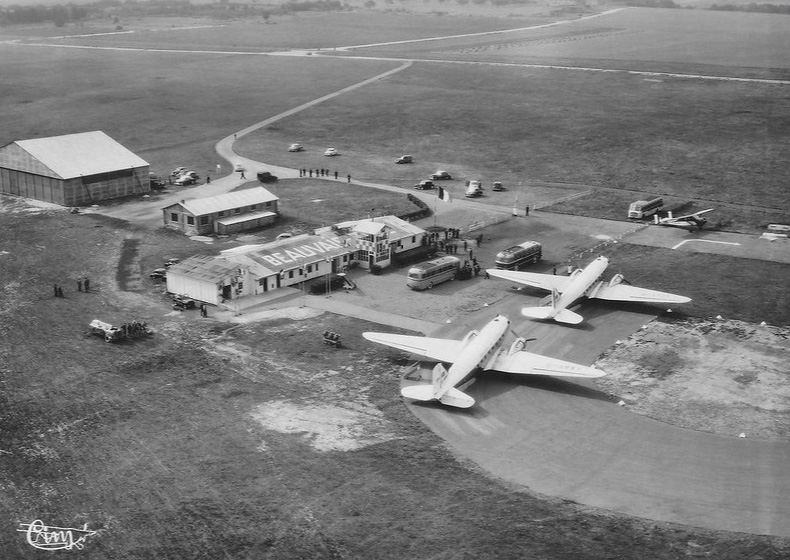
Commercially, big changes were imminent at both the Lancashire Aircraft Corporation and Skyways, with the shipping company Bibby Line taking an interest in Skyways in early 1955. Another shipping line, P&O, had bought an interest in Silver City’s parent company British Aviation Services/ Britavia and, in December 1956, LAC was bought by the BAS group. Eric Rylands remained in management positions at LAC, Skyways and Salmesbury Engineering. LAC Dakotas G-AMWV and G-ANAE were assigned to the newly-assembled Silver City Northern Division based in Blackpool. The division also included the newly-acquired Manx Airlines and Dragon Airlines. Manx brought Dragon Rapides and a single Dakota to the group and Silver City contributed Dakotas such as G-AMYV and G-AMYX – the latter was to become a long-term associate of G-AMWV. G-AMWV and her LAC sisters continued to operate in their own colours until the end of the 1957 season when they were assimilated into the Silver City operation, ‘WV being registered to the new owner on October 28th. Extra Dakotas were added with G-AMJU purchased from Skyways and delivered to Blackpool on 28th February 1957. She was still there on March 8th, sporting no titles, but soon joined the rest of the fleet.
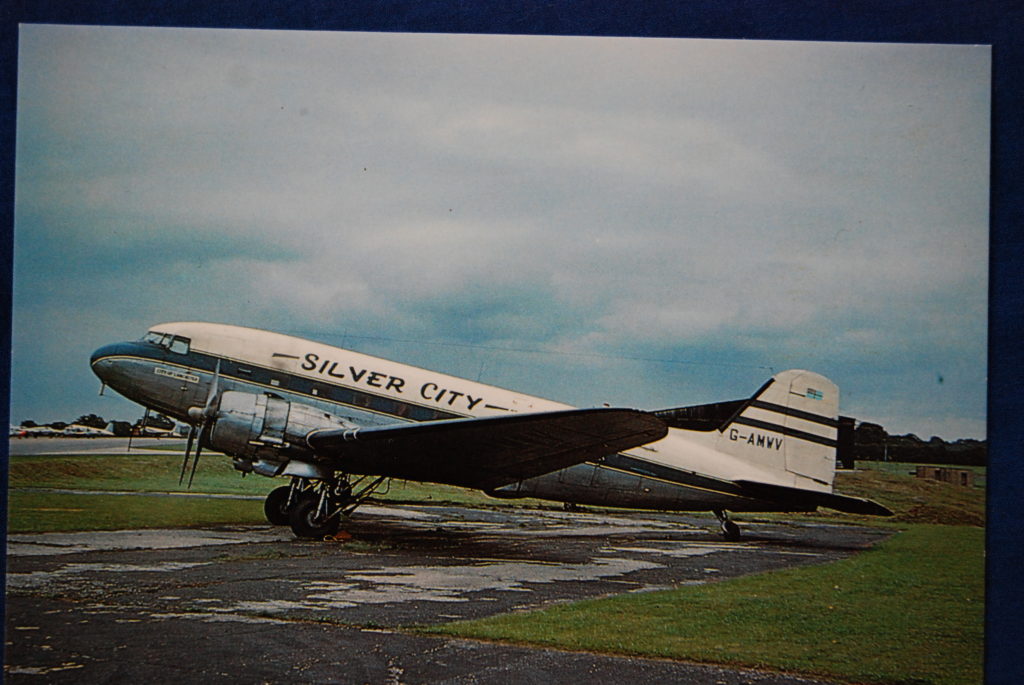
Silver City was one of British Aviation’s most charismatic companies and brought the concept of airborne car ferry services to the general public. Their long and illustrious history is too involved to be explored here, but the North of England/ Irish Sea operation is central to the G-AMWV story. It built upon LAC’s good work and retained the Dakotas while the DH Rapides were replaced by Manx Airlines’ DH Herons. An ambitious international network connected Blackpool, Leeds and Newcastle with European destinations such as Amsterdam, Ostend, Brussels, Hamburg and Dussledorf (10). The latter two cities were served by Dakotas in 36-seat mode as were holiday routes between Newcastle and Blackpool and the Isle of Man. The stalwarts of the fleet were awarded appropriate city names: ex-LAC aircraft had northern names (G-AMWV was ‘City of Lancaster’, G-ANAE ‘City of Newcastle); the original Silver City fleet identified with southern cities (G-ANLF was ‘City of Cambridge’, G-AMYV ‘City of Oxford’, G-AMZB ‘City of Guildford’). Promoting the Kent air ferry service, G-AOBN was ‘City of Canterbury, G-AMYX ‘City of Rochester’, while a few names went off piste: G-AIWC is sometimes quoted as ‘City of Tripoli’ but did, in fact, carry the more credible ‘City of Lincoln’ prior to her move to Libya. G-AJAV was ‘City of Hollywood’ – no, no idea why.
Reflecting how aviation history often highlights contemporary issues, Silver City Dakotas also flew Manchester to Wick services for the Nuclear Power Group (NPG) during the development of the Dounreay and Windscale power stations (10).
The busy schedule required extra aircraft to supplement the existing fleet and both Aer Lingus and Cyprus Airways leased Dakotas to Silver City during 1958 and 1959. Maintaining the Irish flavour, a new route between Blackpool and Dublin was inaugurated by G-AMWV on May 15th 1959 in association with Aer Lingus. G-AMWV, G-AMJU and G-ANAE were all based at Blackpool to operate passenger schedules to Belfast (Nutts Corner), Ronaldsway (IoM), Jersey and Ostend. A nightly freight/ newspaper service was flown to Belfast and additional charters were undertaken from Manchester to the Continent, Norway and Scotland. The NPG flights to Wick continued and G-ANAE flew RAF support operations to Leeming and Lindholme (11).
G-ALPN, named ‘City of Belfast’, and G-AKNB, ‘City of Bradford’, joined the northern fleet on November 18th and December 11th 1959 respectively and operations continued apace throughout the early 1960s. G-AMWV was noted operating flights from Blackpool to Jersey on 19th January 1960 and, two days later, to Cognac in France.
Manx Airlines had tried to establish Bristol Freighter links to Northern Ireland and Castle Kennedy, near Stranraer, as early as 1955 and Silver City briefly maintained these with routes between both Woodvale and Castle Kennedy and Newtownards. Local historians have suggested that Dakotas also flew non-vehicle services into Castle Kennedy with a view to serving the Glasgow hinterland. With car ferry fares quite high, £7 each way for a car, £2-50 for a passenger, there was little to be gained from the Wigtownshire services and they were abandoned by November 1957. In 1956 Manx had also operated B170 routes between the IoM and Silloth in Cumbria but Silver City decided not to continue with these. However, in 1960 Cumberland County Council bought the old airfield at Crosby-on-Eden, near Brampton, andit opened the following year as Carlisle Airport. G-AMWV flew an inaugural Isle of Man to Carlisle flight on 27th May 1961 and was joined by G-AKNB and G-ANAE on services during June ’61 (12)
Eric Rylands had shifted his interests to Skyways operations, having purchased Bibby Line’s holding in late 1960, and continued to promote his coach-air concept. Silver City could also see the benefits of this model – indeed, their car ferry operations were based upon the minimum possible distance being by air. They applied for licences to operate ‘Silver Arrow’ flights from Leeds, Glasgow and Newcastle to Le Touquet in France with Dakotas and Viscounts. Birmingham, Manchester and Blackpool would be linked to Le Touquet by Viscount services and all onward connections to Paris would be via SNCF rail services. However, events overtook these plans when Silver City became part of the British United portfolio during 1962. By November 1st 1962, British United (Channel Islands) Airways had been formed to assimilate Silver City’s Northern Division and Jersey Airlines Dakota operations. Maintenance bases were located at Jersey, Blackpool and the Isle of Man.
G-AMWV was one of the core Dakotas in what became a larger fleet assembled from Silver City (‘WV, G-AKNB, G-ALPN, G-AMHJ, G-AMJU, G-AMYV, G-AMYX, G-ANAE, G-AOBN), Transair (G-AMPZ, G-AMRA, G-AMSV), Jersey Airlines ( G-AMYJ, G-AMZF, G-AMZG, G-ANEG, G-ANTB, G-ANTC, G-AOUD) and Hunting Clan (G-AMHJ). JWR Taylor’s Civil Aircraft Markings for 1963 attributes all but three of these aircraft to BU(CI)A but, by the following year, G-AMWV and other ex-Silver City Northern Division Dakotas were listed as being registered to British United Air Ferries while the Jersey aircraft remained BU(CI)A property. In fact, most of the latter group were registered to the Jersey Airlines investment arm, Alares Development Company Ltd.
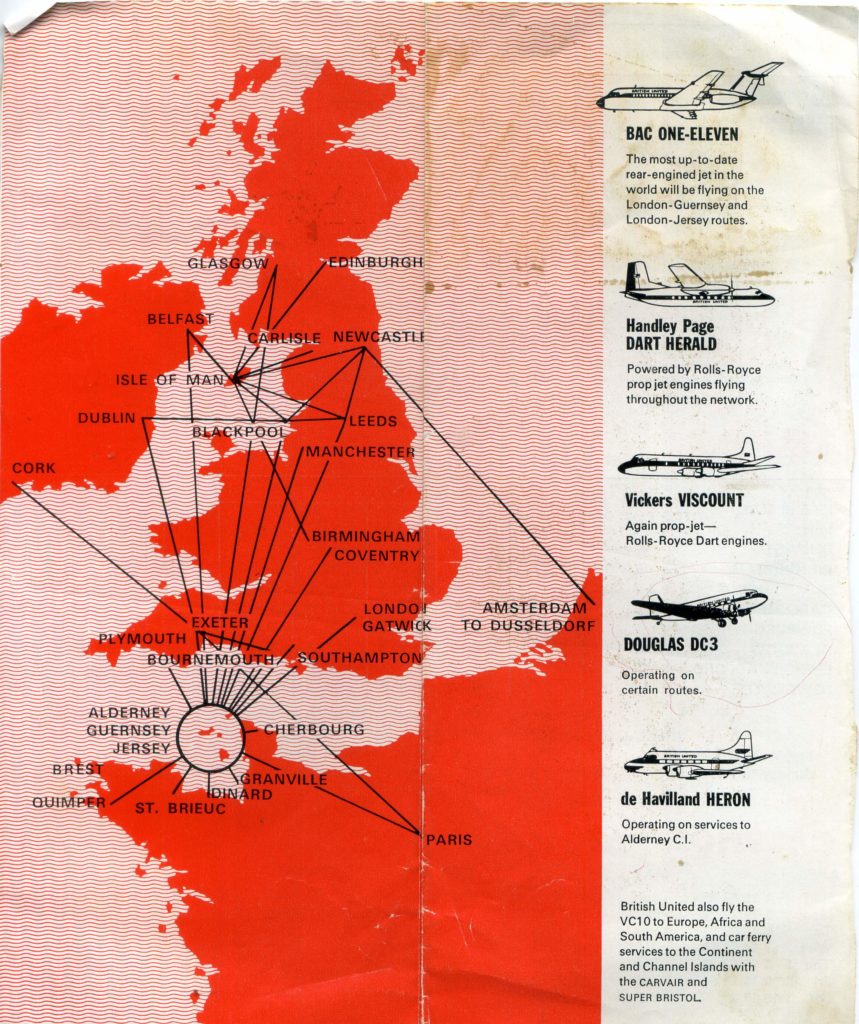
As the route map shows, the Isle of Man and the Channel islands continued to provide the focal points, but the northern cities, Scotland and Ireland were also well served. BU(CI)A produced individual timetables for each destination, mostly featuring bathing belles posing coyly in one-piece swimsuits to encourage holidaymakers to step aboard.
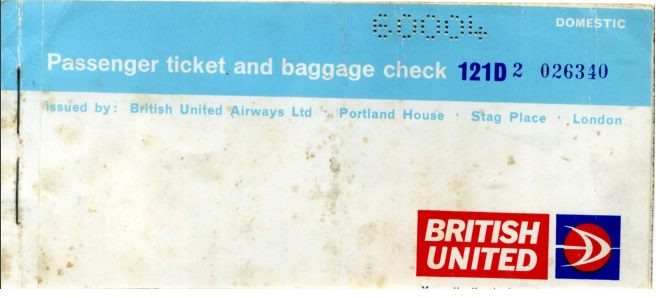
The Dakota fleet was exceptionally busy through the mid-sixties but, amid the success, the first signs of change were on the horizon. The Irish Sea services were gradually adopting turboprop aircraft: Aer Lingus Fokker F-27 Friendships had been early visitors to Ronaldsway and Cambrian operated their Liverpool to Isle of Man services with Viscounts rather than DC-3s. BU(CI)A were putting together an extensive fleet of elegant Handley Page Dart Heralds and, as these took over from the Dakotas, disposals of the older aircraft commenced.
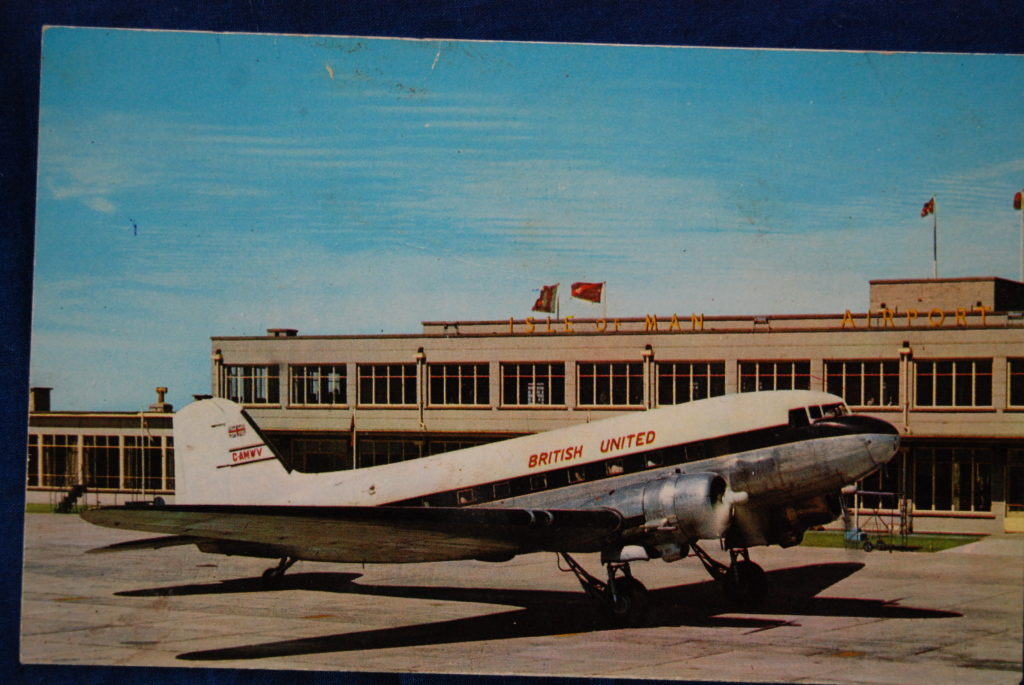
G-AMWV and G-AMWX were part of the first tranche of disposals when they departed to Dublin to join Air Charters of Ireland. Many of the former Northern Division fleet were overhauled at Ronaldsway prior to disposal. In those days it was much easier to access airports and I was fortunate enough to be invited to visit the British United (Manx) hangar in the summer of 1968. G-ALPN and G-ANTC were under cover while G-AMYV was parked behind the hangar and looked like a candidate for the axe. In the event, it appears to have been G-ALPN which was scrapped while ‘YV departed for a new career in the Middle East (13).
A substantial part of the BU(CI)A fleet transferred to Morton Air Services at Gatwick and, on 1st November 1968, Morton, BU(CI)A and BU(Manx) were amalgamated to form British United Island Airways. By this date G-AMWV and her companion G-AMYX had been flying services from Ireland for two years as EI-APB and EI-APJ respectively. G-AMWV had joined the Irish registry on 29th March 1966 with Dublin-based Air Charters of Ireland. The airline had been formed earlier that year and traded as Hibernian Airlines. EI-APB was delivered on April 5th and commenced work four days later. The aircraft visited Manchester Ringway on April 20th on a charter flight. By May 16th 1966 a national seaman’s strike had begun in Britain and the air cargo industry expanded accordingly. EI-APB was recorded at airports all over Britain during the next 10 days: Exeter on 15th, Glasgow and Castle Donington on 19th May, Speke and Heathrow on 21st. By the time the strike was settled on July 1st, Britain had suffered a slump in the pound and the declaration of a state of emergency – companies such as Hibernian and Irelfly should have made their fortunes. EI-APB had visited Speke 91 times during the dock strike on services between the Isle of Man, Belfast, Blackpool, Dublin and Liverpool. Occasionally, up to nine flights were completed each day (14). The Hibernian aircraft worked alongside Gregory Air Services’ Dakota G-AKJH at Speke during the strike and would do so again when the Irish airline leased ‘JH the following year.
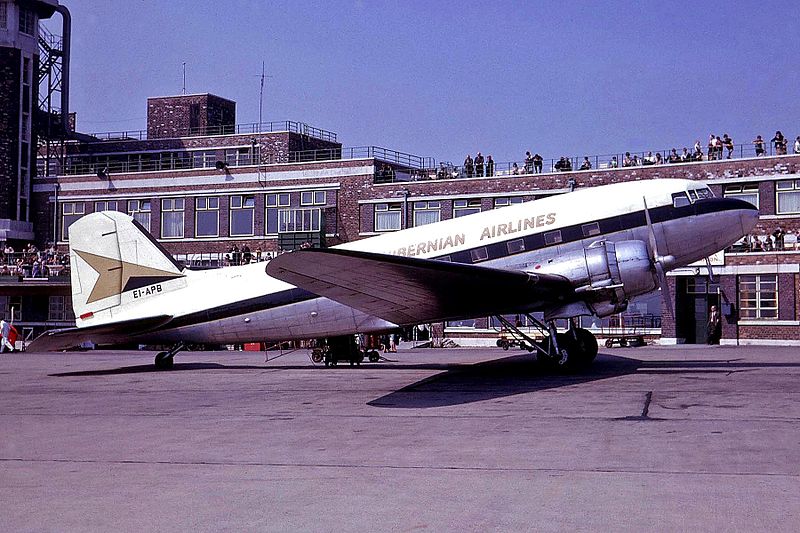
Hibernian added a second Dakota, EI-APJ (ex-G-AMYX), in July 1966 and the newcomer was delivered from Blackpool to Dublin. Coincident with Hibernian’s expansion south of the border, another airline was developing from a Northern Ireland base. Emerald Airways had been established in 1965 and started operations from the newly-revived airfield at Eglinton that autumn using DH Herons. During 1966, they too had experienced full capacity during the seaman’s strike and were planning an ambitious expansion with new aircraft. Two Short Skyvan’s were ordered to replace the leased Herons but delivery was too slow to catch the peak summer business in 1966. Eventually, Skyvan G-ATPF was delivered direct from the Belfast factory during August and scheduled services began the following month. However, crew training was slow and the Skyvans were just not large enough to cater for demand on the lucrative Ulster to Scotland routes. The solution arrived in mid-December when Hibernian purchased a 55% share in the Northern Irish company and immediately transferred the two Dakotas to Emerald operations. The full history of the combined airline will be dealt with in another thread but, from EI-APB’s perspective, it saw the aircraft painted in Emerald titles and operating her first flight on December 13th 1966. EI-APJ had flown the first service for the new combine on December 10th 1966 (6) and during 1967 the two Dakotas continued to fly routes between Belfast, Eglinton, Prestwick, Glasgow and Shannon as well as passenger charters from the Isle of Man to Dublin and other ad hoc cargo charters. EI-APB returned to Dublin on April 2nd 1967 to cover Hibernian’s summer charter programme although EI-APJ also operated Dublin to Ronaldsway flights during the summer, still wearing Emerald titles (15).
G-AKJH was leased from Gregory Air Services during summer 1967 along with Skyways’ G-AMWW and Strathair’s G-AOGZ. The first two were placed on the Irish register as EI-ARR and EI-ARP respectively. EI-APB reverted to her UK registration on 28th June 1967 and arrived at Aldergrove on July 19th with Emerald listed as her new charterers. Crew training was undertaken, but she only commenced work for Emerald when EI-APJ returned to Hibernian on August 19th and EI-ARR returned to Gregory’s. The flights between Glasgow and Prestwick and the Northern Ireland airports of Aldergrove and Eglinton suffered from variable load factors and Monday morning’s Eglinton to Glasgow was the last northbound service. On November 15th G-AMWV flew the last Prestwick to Aldergrove service with only 11 passengers on board.
Despite the appearance of prosperity, Hibernian had been in financial difficulties and had halted operations in October 1967. Emerald Airways followed them into liquidation on 21st December but a new company had already been formed in Belfast on December 1st. under the auspices of travel entrepreneur William R.Best. G-AMWV was chartered to join the new operation, Ulster Air Transport.
G-AMWV flew to Gatwick on January 15th 1968 for an overhaul and repaint by Air Couriers. ‘WV arrived back in Belfast ten days later and commenced crew training on 27th and 28th. Some charter operations may have been conducted in February, but little else took place while ATLB considered Ulster’s application to take over the Emerald services. Route training between Aldergrove and Glasgow took place on March 5th and scheduled operations started on April 8th 1968 with G-AMWV flying from Aldergrove to Glasgow. Unfortunately, ‘WV promptly developed a fault which delayed the departure of the return flight. This had a knock-on effect in delaying the introduction of both this route and a second planned route between Belfast and Prestwick while ‘WV was despatched to Gatwick and, subsequently, Southend for maintenance work. G-AMWV’s former BU(CI)A colleague G-AMJU was purchased and arrived at Aldergrove on April 27th. It got to work promptly, flying a charter to Glasgow the same afternoon. Another ex-BU(CI)A Dakota, G-ANAE, had also been leased by UAT between January 18th and April ’68 (probably). A third Dakota from the British United stable, G-AKNB, had also been due to join the airline but this didn’t happen (6). Newspaper flights were also commenced and, on April 29th, G-AMJU commenced a daily service between Ballykelly and Glasgow. G-AMJU was painted in full Air Ulster colours and christened ‘Derry Maid’ to G-AMWV’s ‘Ulster Maid’.
G-AMWV had returned to service and flew inaugural Aldergrove to Prestwick UL202 flight on the morning of May 22nd. The flight was designed to link up with transatlantic connections and, as with Manx Airlines and Emerald Airways flights in preceding years, the Dakota was often observed skirting around the prominent rocky island of Ailsa Craig en route to Ayrshire. This service was flown four times per week while Aldergrove to Glasgow and return was flown every day. Following the pattern established by Emerald, a mix of scheduled flights, cargo charters and inclusive tours was flown during 1968 and 1969. G-AMWV operated a Belfast to Bristol charter on June 20th 1968 and an Aldergrove to Dinard freight run on June 29th. A passenger charter between Aldergrove and Exeter was interrupted on July 27th when G-AMWV developed engine trouble and had to land at Liverpool. The problem was serious and ‘WV was grounded at Liverpool for ten days meaning that G-AMJU had to fly an extremely demanding schedule. Returning to service in August, ‘WV completed a charter between Benbecula in the Hebrides and Quimper, Brittany, on 9th carrying lobsters. G-AMWV flew a similar service between Orkney and Stavanger on September 21st/ 22nd.
Air Ulster continued operations with the two Dakotas and three crews during the winter of 1968 and, in Spring 1969, the airline applied for further schedules between Ulster and Dublin, Cork and Shannon. G-AMJU remained reliable and G-AMWV continued operations, flying a Belfast to Edinburgh charter on February 22dn 1969 carrying Irish Rugby supporters. ‘WV was still requiring maintenance and, on March 10th she was withdrawn from service at Scottish Aviation, Prestwick.
A replacement Dakota, G-AGJV, was leased from Central Air Services (CAS) and Air Ulster also took over a CAS commitment to fly a weekly Inclusive Tour between Birmingham and Ostend on Sundays. G-AGJV’s arrival also enabled the extension of services from Glasgow to Edinburgh on a couple of occasions and, by May 20th 1969, G-AMJU was flying the full Ballykelly to Glasgow to Edinburgh route six times per week. Skyways’ Dakota G-AMWW also supplemented the fleet during 1969 but the airline was committed to switching to turboprop equipment. In early 1969 operations had also been merged with Liverpool-based Phoenix Airlines, a group of ex-British Eagle employees who planned to fly Skyvans. In a very similar move to the Hibernian/ Emerald tie-up, Ulster took over all flying using their own Dakotas. As with many airlines, the attempt to graduate from DC-3s to turboprop equipment proved difficult. An Aer Lingus Viscount, EI-APD, was leased in July 1969 and, from then until 6th January 1970, operated most of Air Ulster’s scheduled services. Dakotas were still employed where the passenger load factor was insufficient for a Viscount. EI-APD also flew a number of longer range charters between Ulster and Germany, Birmingham, Bristol and Southend during October.
However, economics weren’t looking good for Air Ulster and, despite a successful Christmas season, the airline was wound-up in January 1970 following a final Dakota flight on 3rd and the final Viscount flight on January 6th. Scottish Aviation was probably owed money and any further overhaul work on G-AMWV was halted immediately.
Dismantled at Prestwick, G-AMWV was destined to join the airport fire heap. The arrival the ex-Flughjalp DC-6 TF-AAD provided an abundance of hulks for fire training and ‘WV was sold to the Abbotsinch Fire Service for £500 and transferred to Glasgow by low loader.
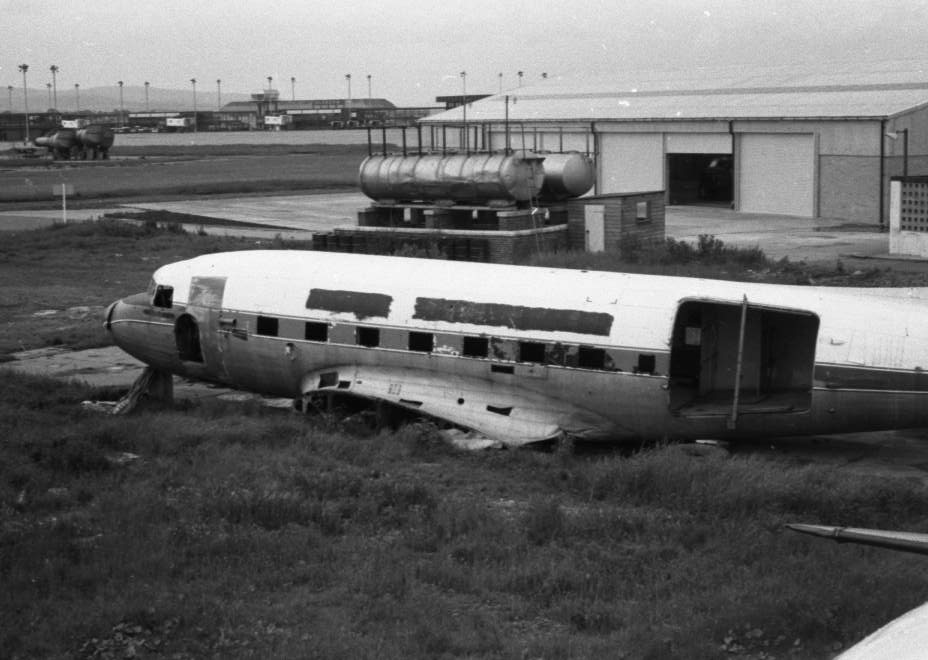
References & footnotes:
(1) The outline dates and history of ownership changes throughout the article are taken from JMG Gradidges’s ‘The Douglas DC-3 and its predecessors’ published by Air Britain, 1984.
(2)This was the second milk airlift and seven airlines contributed thirteen aircraft to the operation. The milk was transported in churns and had to be loaded by hand, 110 per Halifax, 56 per Dakota. A full description can be found at http://derbosoft.proboards.com/thread/3820.
(3) From ‘The Berlin Airlift’ by Arthur Pearcy, Airlife 1997.
(4) Eric Rylands was instrumental in Skyways following its acquisition by LAC and, subsequently, as the independent Skyways Coach Air. Indeed, when I worked briefly at Air Freight/ Skyways Cargo in 1973 Eric Rylands was still the Chairman.
(5) Indeed, at the time, the aviation industry felt that the sale of the Yorks by the state airline should have been arranged by public tender and that LC had negotiated a shrewd deal.
(6) Much of the airline history detail is from Tony Merton-Jones excellent ‘British Independent Airlines 1946-1976’ published by The Aviation Hobby Shop.
(7) A good picture of G-ANAE in LAC colours at Manchester Ringway during May 1954, taken by R.A.Scholefield, can be found at https://abpic.co.uk/pictures/view/1319853
(8) Flight International for 30/9/1955 quotes September 21st 1955 as the date for the inaugural flight by VIPs with scheduled services commencing on 30th September.
(9) From Lympne Airfield at War and Peace by Anthony J.Moor, 2014, published by Fonthill Media.
(10) and (11) From ‘British Independent Airlines 1946-1976’ , Tony Merton-Jones.
(12) A selection of photos by all three aircraft appears on the Air Britain www.abpic.co.uk website. Images by Mike Hines.
(13) Of the old Silver City fleet, G-AMYV travelled to Southend where she was painted as ‘204’ and departed for service with the South Arabian Federation Air Force. Coincidentally, G-ANAE was also Yemen-bound, departing on 17/1/1968 for Aden and a new life with Brothers Air Services. G-ANTC joined Hunting Surveys and went on to have a long life culminating in retirement in Colombia. G-AMJU eventually went to join G-AMWV at Ulster Air Transport while G-AKNB went to Intra Airways and survives today (possibly as a Basler BT-67). Only G-ALPN failed to survive, flying for the last time on 10/10/1967 and officially withdrawn from use on 5/11/1968 following her CofA expiry on 14/3/1968. Probably scrapped at Ronaldsway, Air Britain Digest reported a large section in a West Bromwich scrap yard, so the remains were probably taken to the mainland by ferry.
(14)from http://derbosoft.proboards.co./thread/20851/complete-visiting-aircraft-logs-review
(15) Much of the information on Emerald Airways and Air Ulster operations is taken from Tony Merton-Jones excellent article ‘Ulster’s New York Connection’ published in Propliner #20, Winter 1983.
Hits: 1348
